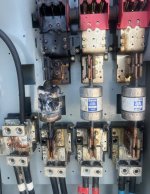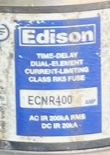Sparky_ron
Member
- Location
- Texas
- Occupation
- Master Electrician
My customer has a EATON DG326NRK 600A fusible 3-pole 250V SAFETY SWITCH. So, the other day one of the fuses literally caught on fire (instead of blowing) and started a small fire inside of the enclosure.. it mainly melted the plastic section around the copper blades. There are 3” conduits coming into the top, bottom, and sides of the enclosure.
QUESTION: Rather than replacing the whole Nema3 enclosure and removing all or some of the conduits to be able to take it out, I was hoping I could change out the interior guts & safety handle, and install the new guts and handle from an [identical] safety switch. It looks pretty simple. There’s 5/16 bolts from the can to the backing that holds the fuse holders, that part should come off really easily. My concern was where it attaches to the handle and being able to remove that also.
Has anyone ever attempted this? If so can you reach out and tell me how it went. Thank you Ronnie
QUESTION: Rather than replacing the whole Nema3 enclosure and removing all or some of the conduits to be able to take it out, I was hoping I could change out the interior guts & safety handle, and install the new guts and handle from an [identical] safety switch. It looks pretty simple. There’s 5/16 bolts from the can to the backing that holds the fuse holders, that part should come off really easily. My concern was where it attaches to the handle and being able to remove that also.
Has anyone ever attempted this? If so can you reach out and tell me how it went. Thank you Ronnie




